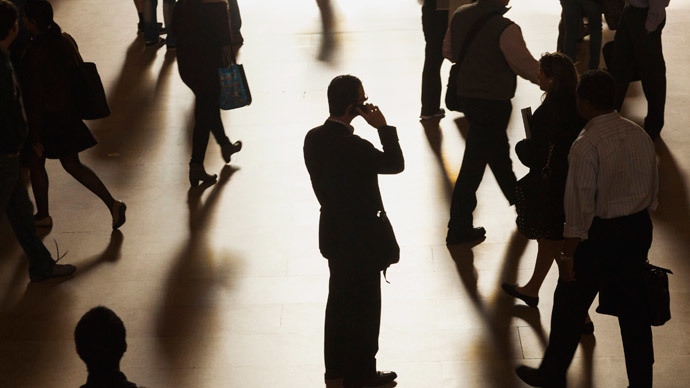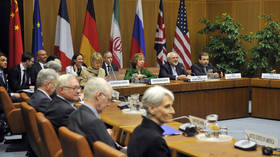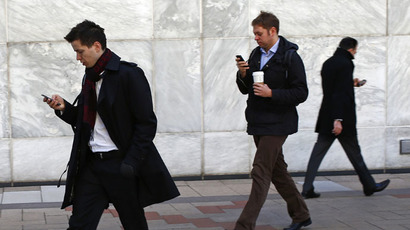Detective reveals expansive use of StingRay surveillance in Baltimore

The Baltimore Police Department used controversial cell phone surveillance tools more than 4,000 times since 2007, an officer revealed this week, but has stayed largely silent on the topic until now upon orders from the Federal Bureau of Investigation.
In a rare admission, Detective Emmanuel Cabreja testified in court on Wednesday that the city has deployed “cell site simulators,” including the increasingly prevalent StingRay device, 4,300 times during the last eight years. According to the Baltimore Sun, Cabreja said he personally used that tool, and another known as a ‘Hailstorm’, upwards of 800 times during only a two-year span.
When activated, portable machines like the StingRay mimic cell towers in order to trick mobile devices within a given range to send over data, giving police geolocation details and other information for upwards of thousands of phones in a single instance. Law enforcement agencies have increasingly relied on cell site simulators in recent years for the device’s ability to narrow in on suspects during criminal investigations.
Privacy advocates have taken aim at that vast surveillance power and are now raising new questions following Cabreja’s admission this week that the FBI is trying tooth and nail to keep the use of the devices under wraps.
Amazing StingRay hearing today: Q: Does FBI instruct you to withhold evidence in spite of ct. order? Detective: Yes http://t.co/iFJXtorD0N
— Brad Heath (@bradheath) April 9, 2015
In court on Wednesday, Cabreja produced a nondisclosure agreement between the FBI and the Baltimore PD that explicitly orders authorities not to reveal information about the cell surveillance tools in its arsenal. Existence of the NDA in itself is not particularly new, but the details contained therein provide a previously unseen look at the federal government’s efforts to ensure as much information as possible about the spy devices stay sealed.
"Does this document instruct you to withhold evidence from the state's attorney and Circuit Court, even upon court order to produce?" the detective was asked during this week’s hearing, according to the Sun.
"Yes," Cabreja reportedly responded.
NEW: For the 1st time, a copy of the non-disclosure agreement Baltimore authorities signed w feds to use Stingray https://t.co/zqI6wiGK7N
— Justin Fenton (@justin_fenton) April 8, 2015
Indeed, a copy of the document published by the Sun on Wednesday orders the BPD not to “distribute, disseminate or otherwise disclose any information” about the tools to the public, and not even to other law enforcement agencies without the expressed written approval of the FBI. According to the bureau, "disclosure of this information could result in the FBI's inability to protect the public from terrorism and other criminal activity.”
Even in legal proceedings, according to the document, police are barred from discussing the tool per the FBI’s orders. The BPD and the Office of the State’s Attorney for Baltimore “shall not, in any civil or criminal proceeding, use or provide any information concerning” the equipment, its software, manuals or related documentation beyond the evidentiary results obtained through its use.
The document specifically says to leave information about the devices absent from pre-trial matters, including search warrants, affidavits, court orders and more without approval of the FBI, and instructs the BPD and Maryland Attorney’s Office to seek dismissal of any cases that might otherwise yield to disclosures about the devices.
How much does BPD love this device? The head of their unit that uses Stingray retired and now works for the manufacturer
— Justin Fenton (@justin_fenton) April 9, 2015
"This is a very expensive and very invasive technology developed for military use, now used on the streets of America," Nathan Freed Wessler, a staff attorney with the American Civil Liberties Union, told the Associated Press. "The public has a right to know how taxpayer dollars are being spent, and if our constitutional rights are being respected.”
According to the Sun, Cabreja met with the FBI last week ahead of testifying and was “coached” on what to say in court. Wednesday’s pre-trial hearing concerned the use of a cell site simulator by the BPD to locate two men that were charged in 2013 with armed carjacking, armed robbery and theft, among other charges, according to the paper. Ultimately, the police located the men by honing in on a stolen cell phone using a ‘Hailstorm’, an upgraded, more powerful version of the StingRay.
Previously, Ars Technica reported that police in Baltimore, Oakland County, Michigan and Phoenix, Arizona, had separately acquired Hailstorm systems in 2013. The devices are valued at $169.203 apiece, according to the website.
Earlier this week, documents released in western New York State relevant to a StingRay lawsuit there revealed that authorities in Erie County used the tool at least 47 times between May 1, 2010 and October 3, 2014, and only once pursuant to a court order. The Florida Department of Law Enforcement previously acknowledged that its officers used the device about 1,800 times, and former US Judge Brian L. Owsley, a law professor at Indiana Tech, told the Sun he was "blown away" by Baltimore’s numbers.













